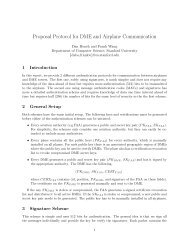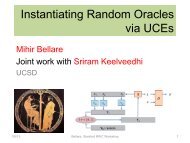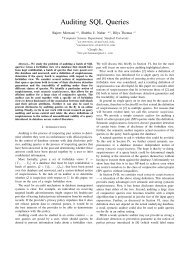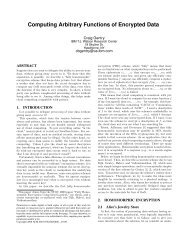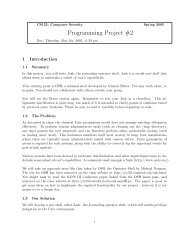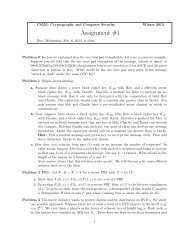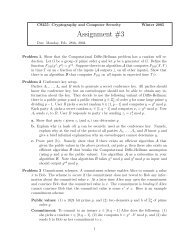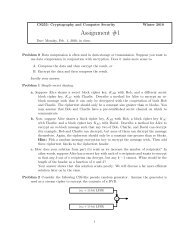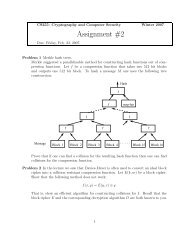PBC Library Manual 0.5.11 - Stanford Crypto Group
PBC Library Manual 0.5.11 - Stanford Crypto Group
PBC Library Manual 0.5.11 - Stanford Crypto Group
Create successful ePaper yourself
Turn your PDF publications into a flip-book with our unique Google optimized e-Paper software.
Chapter 3. Pairing functions<br />
An application should first initialize a pairing object. This causes <strong>PBC</strong> to setup curves, groups and other<br />
mathematical miscellany. After that, elements can be initialized and manipulated for cryptographic<br />
operations.<br />
Parameters for various pairings are included with the <strong>PBC</strong> library distribution in the param subdirectory,<br />
and some are suitable for cryptographic use. Some programs in the gen subdirectory may be used to<br />
generate parameters (see Chapter 7). Also, see the <strong>PBC</strong> website for many more pairing parameters.<br />
Pairings involve three groups of prime order. The <strong>PBC</strong> library calls them G1, G2, and GT, and calls the<br />
order r. The pairing is a bilinear map that takes two elements as input, one from G1 and one from G2,<br />
and outputs an element of GT.<br />
The elements of G2 are at least as long as G1; G1 is guaranteed to be the shorter of the two. Sometimes<br />
G1 and G2 are the same group (i.e. the pairing is symmetric) so their elements can be mixed freely. In<br />
this case the pairing_is_symmetric function returns 1.<br />
Bilinear pairings are stored in the data type pairing_t. Functions that operate on them start with<br />
pairing_.<br />
3.1. Initializing pairings<br />
To initialize a pairing from an ASCIIZ string:<br />
pairing_t pairing;<br />
pairing_init_set_str(pairing, s); // Where s is a char *.<br />
The string s holds pairing parameters in a text format. The param subdirectory contains several<br />
examples.<br />
Alternatively, call:<br />
pairing_t pairing;<br />
pairing_init_pbc_param(pairing, param);<br />
where param is an initialized pbc_param_t (see Chapter 5).<br />
int pairing_init_set_str(pairing_t pairing, const char *s)<br />
8



